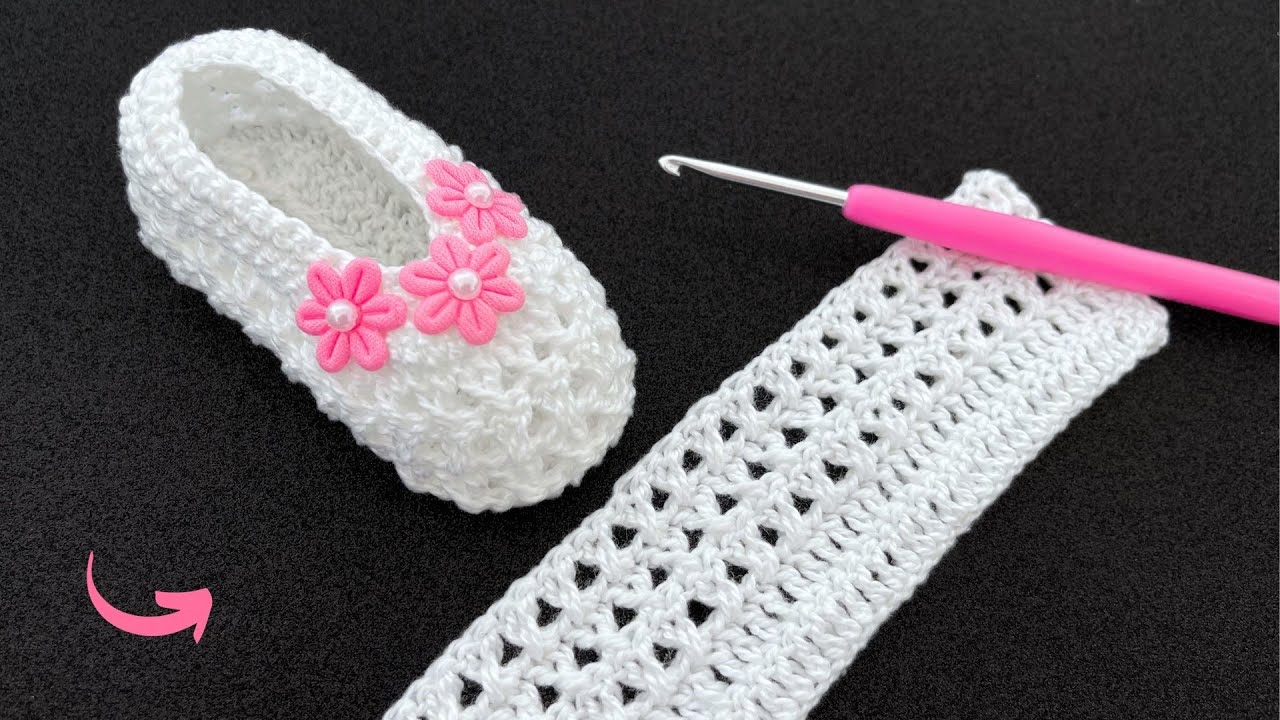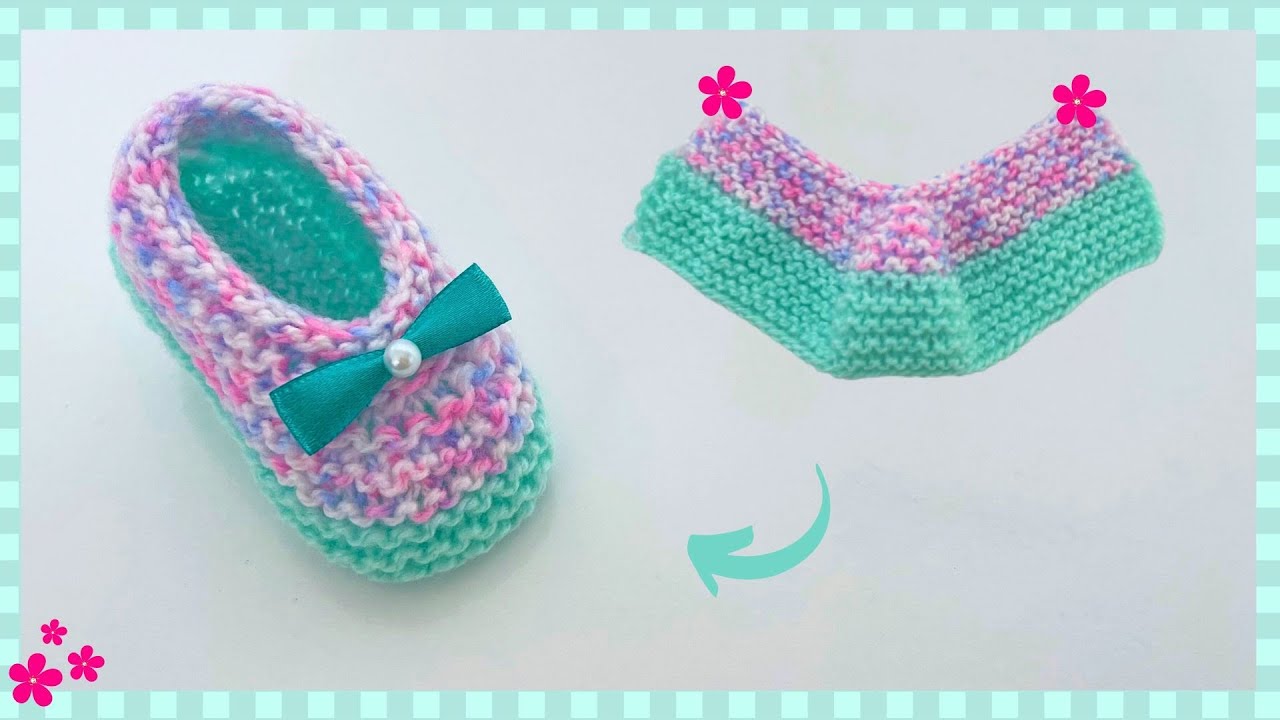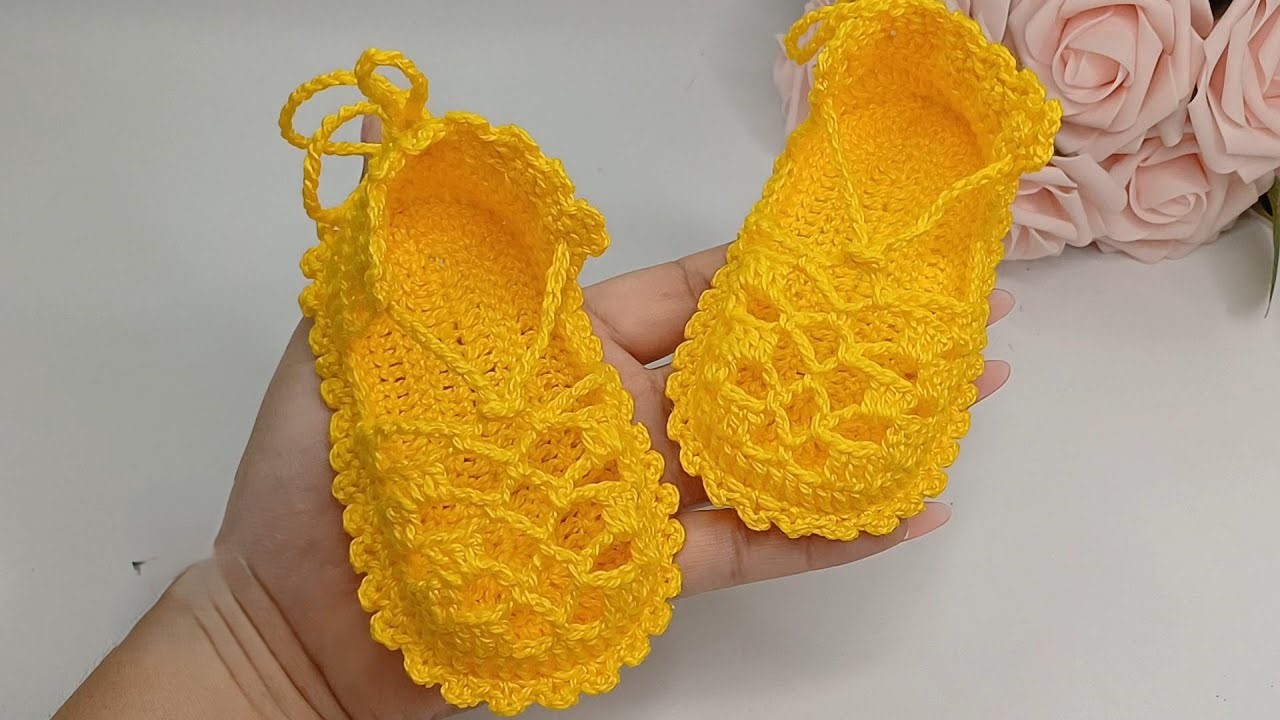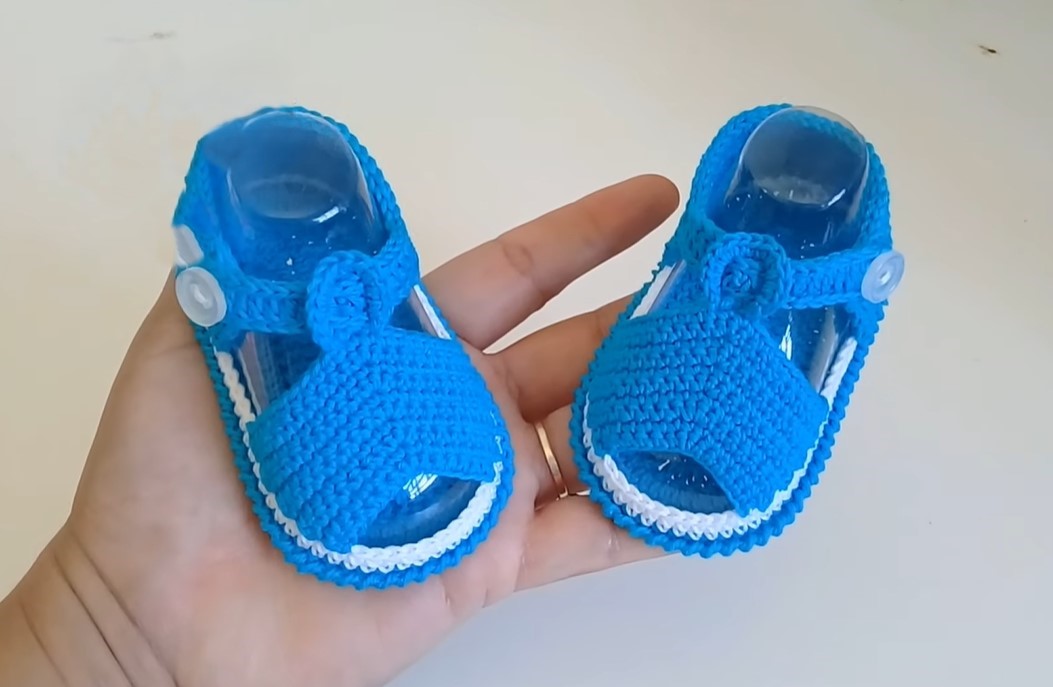These adorable crocheted baby slippers are simply irresistible! Featuring a lovely openwork pattern that’s airy and lightweight, and adorned with three dainty pink flowers, these slippers are perfect for keeping tiny feet stylish and comfortable. The construction is clever and straightforward, making it a rewarding project for crocheters looking for a beautiful finished item.
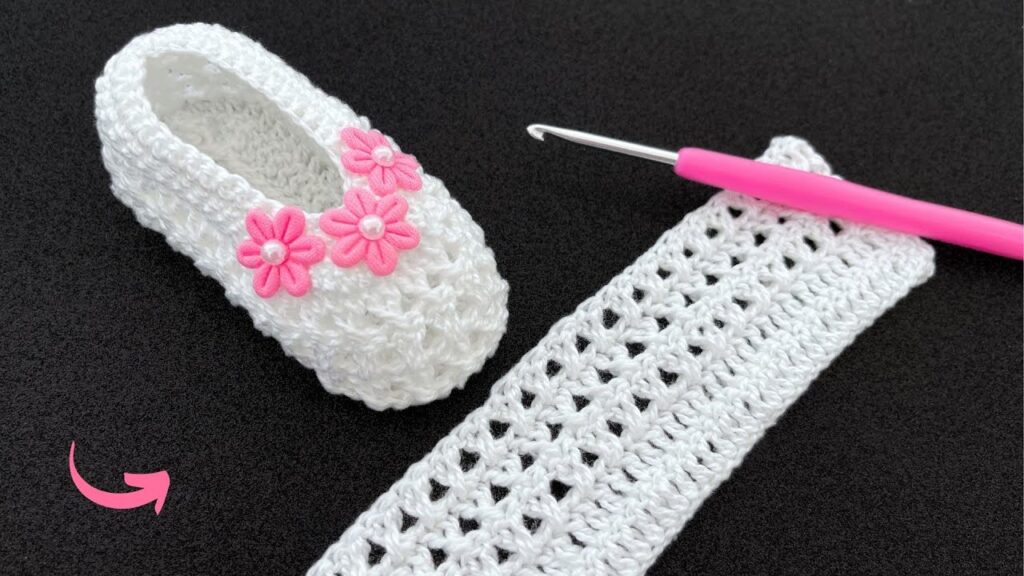
This pattern is suitable for intermediate crocheters, or confident beginners comfortable with basic stitches, simple openwork, and seaming.
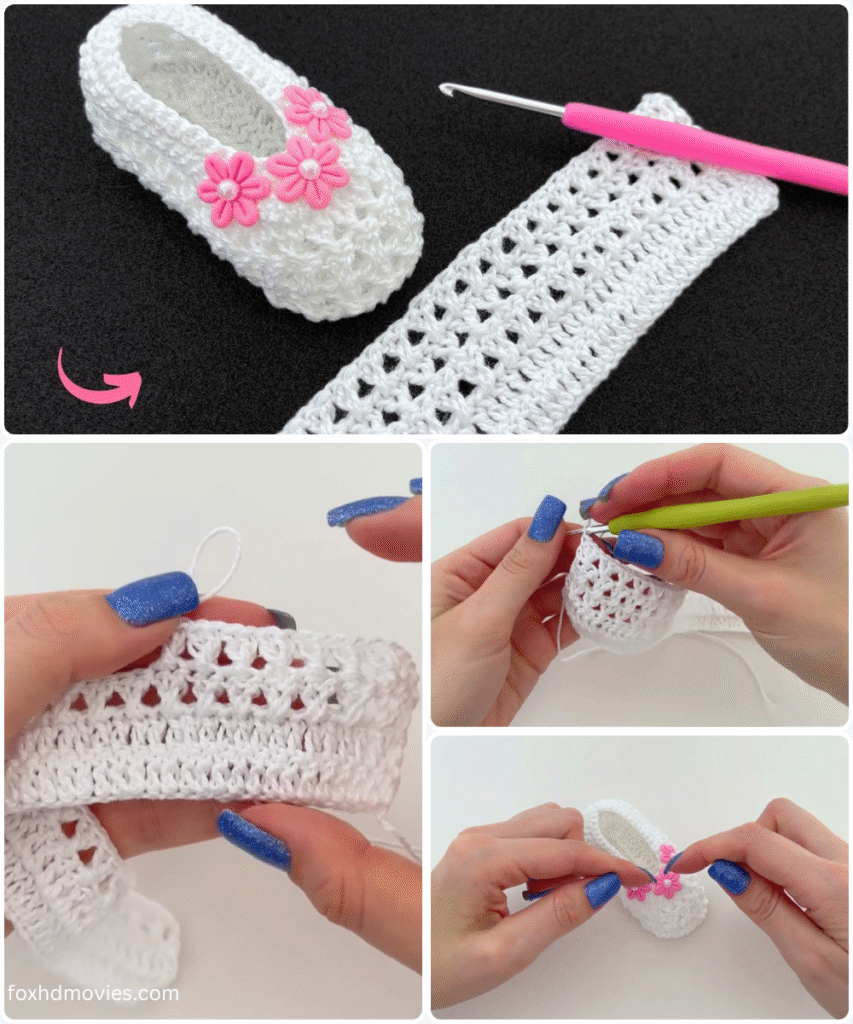
Yarn:
- DK (Double Knit) or Light Worsted Weight yarn in White (Main Color), as pictured. Choose a soft, machine-washable baby-friendly yarn like acrylic or a cotton blend.
- Small amount of DK or Light Worsted Weight yarn in Pink (Contrast Color) for the flowers.
Hook:
- 3.5 mm (US E/4) crochet hook (adjust hook size if necessary to achieve desired fabric and tension).
Notions:
- Tapestry needle for seaming and weaving in ends
- Scissors
- 3 small decorative pearls or beads (for the center of each flower, as pictured).
Gauge (Important for Sizing!):
- For the openwork pattern: A section of (DC, Ch 1) should measure approximately 0.75 inches (2 cm) wide, and 2 rows of the pattern should measure about 0.75 inches (2 cm) tall.
- Always make a small swatch to check your gauge, as it’s crucial for the finished size of the slippers!
Size:
- Newborn to 3 months (approximately 3.5 – 3.75 inches / 9-9.5 cm sole length when finished).
- To adjust for larger sizes, you will need to increase the starting chain for the sole and add more rows for both the sole and the upper sections, ensuring the openwork pattern repeat is maintained.
Abbreviations (US Crochet Terms):
- Ch: Chain
- Sl St: Slip Stitch
- SC: Single Crochet
- HDC: Half Double Crochet
- DC: Double Crochet
- St(s): Stitch(es)
- Sk: Skip
- Sp: Space
- FO: Fasten Off
- BLO: Back Loop Only (insert hook only into the back loop of the stitch)
- V-Stitch (V-st): (DC, Ch 1, DC) in the same stitch/space.
Pattern Instructions:
These slippers are made in two main parts: the sole and the main body/upper, which is then shaped and seamed. The image shows the body as a long, flat piece with openwork.
Part 1: The Sole (Main Color – White)
The sole is worked in continuous rounds to create an oval shape.

- Ch 14.
- Round 1: SC in 2nd Ch from hook. SC in next 11 Ch. 3 SC in last Ch. (Work around the end of the chain). Working along the other side of the starting chain: SC in next 11 Ch. 2 SC in the very last Ch (this is the same ch as your very first SC). Sl St to first SC to join. (28 SC)
- Round 2: Ch 1 (does not count as a stitch). 2 SC in first SC. SC in next 11 SC. 2 SC in next 3 SC. SC in next 11 SC. 2 SC in last 2 SC. Sl St to first SC to join. (34 SC)
- Round 3: Ch 1. 2 SC in first SC. SC in next 13 SC. 2 SC in next 3 SC. SC in next 13 SC. 2 SC in last 2 SC. Sl St to first SC to join. (40 SC)
- This completes the sole. FO, leaving a long tail for sewing the sole to the upper later.
Part 2: The Slipper Body/Upper (Main Color – White)
This section is worked flat in rows, creating the openwork pattern.
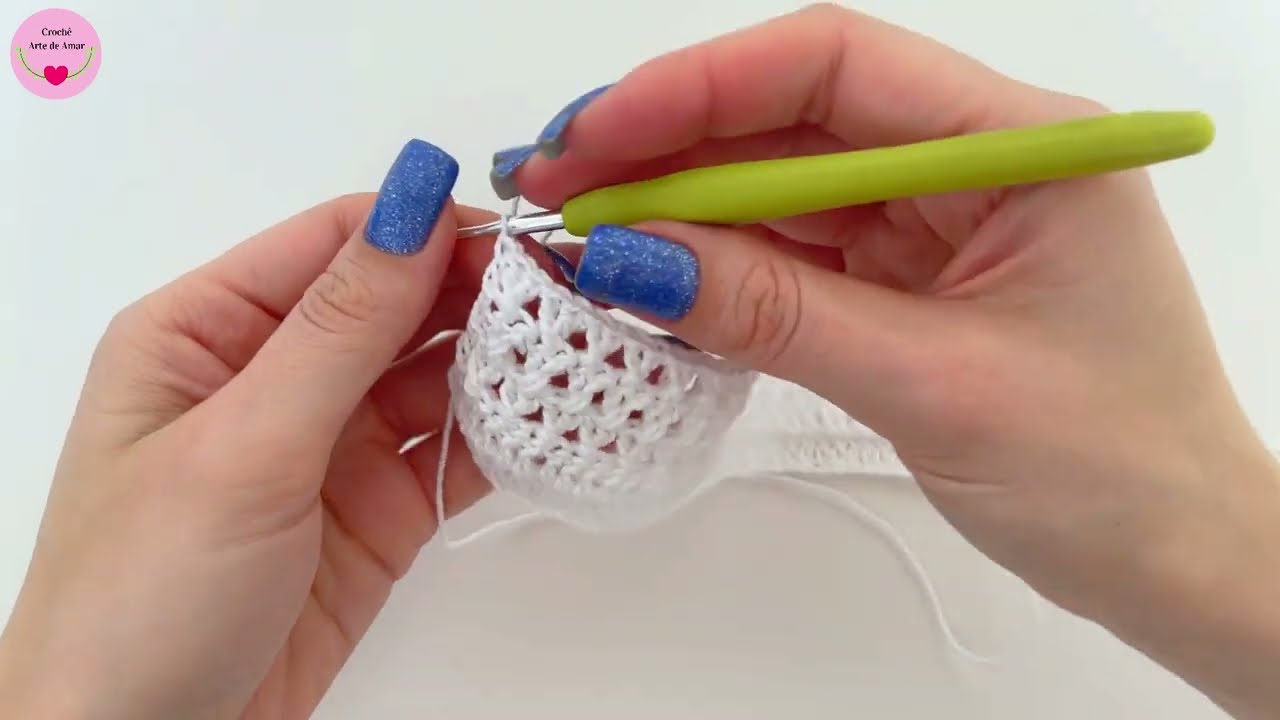
- Ch 29. (This chain will form the main length of the slipper’s body, including the toe and top of the foot).
- Row 1 (RS): DC in 4th Ch from hook (Ch 3 counts as 1st DC). Ch 1, Sk 1 Ch, DC in next Ch. Repeat from * to * across the row. (14 DC and 13 Ch-1 spaces). Ch 3 (counts as 1st DC), turn.
- This creates the initial openwork pattern seen on the flat piece.
- Row 2 (WS): DC in first DC. Ch 1, Sk 1 Ch-1 sp, DC in next DC. Repeat from * to * across the row, ending with DC in top of turning Ch 3. (14 DC and 13 Ch-1 spaces). Ch 3, turn.
- Repeat Row 2 for 10 more rows, or until the piece measures approximately 4.5 – 5 inches (11.5 – 12.5 cm) from the starting chain.
- This creates the main rectangular section of the slipper’s body.
- Next Row (Shaping – RS): DC in 4th Ch from hook (Ch 3 counts as 1st DC). Ch 1, Sk 1 Ch-1 sp, DC in next DC. Repeat from * to * across to the last 2 stitches/spaces. Ch 1, Sk 1 Ch-1 sp, DC in next DC. (This row should have the same number of stitches as previous rows). Ch 1, Sl St in the same last DC. FO, leaving a long tail for sewing.
- This final row might be slightly tapered or just provides a neat edge for seaming.
Part 3: The Flowers (Contrast Color – Pink)
Make 3 flowers as pictured.
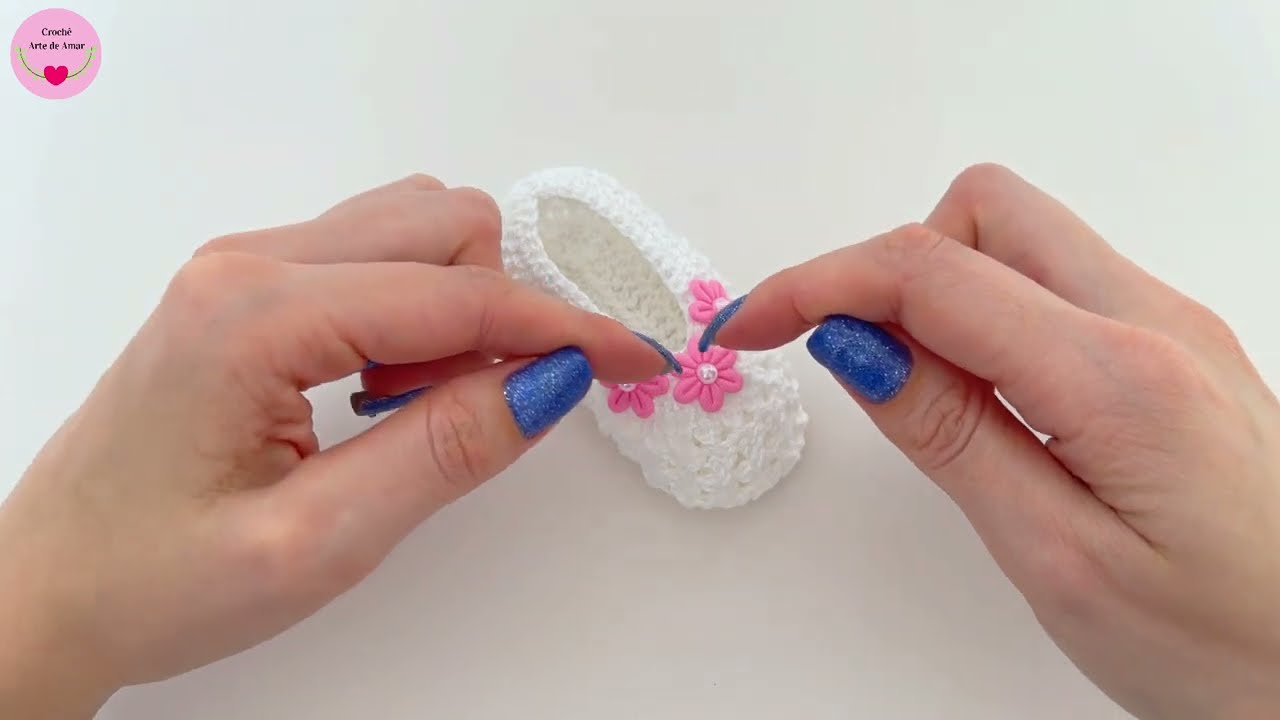
- Ch 2.
- Petals: Work (Sl St, Ch 2, 2 DC, Ch 2, Sl St) all into the 2nd Ch from hook. Repeat 4 more times into the same 2nd Ch from hook. (5 petals total).
- FO, leaving a short tail for weaving in.
- Each flower should look like a small, flat rosette.
Video tutorial
Finishing Your Slipper:
- Weave in all initial loose ends on the sole and the body piece.
- Seaming the Slipper Body:
- Take the long openwork piece. Fold it in half lengthwise, bringing the two long edges together.
- Using your tapestry needle, whip stitch or mattress stitch the long side seam closed. This forms the tube shape of the upper.
- Attaching Upper to Sole:
- With the RS of your sole facing you, align the long seamed edge of the openwork upper to the perimeter of the sole.
- The flat openwork piece should wrap around the sole. The seam you just made will be the center back of the heel. The starting chain edge of the openwork will be the top front of the bootie.
- Using your tapestry needle and the long tail from the sole, securely whip stitch or mattress stitch the upper to the sole, working all the way around the oval. Ensure the upper is centered evenly on the sole.
- Closing the Toe:
- The image suggests the slipper’s toe is slightly gathered or seamed. Carefully fold and stitch the front tip of the slipper closed, gathering it slightly to form the toe shape. Stitch securely.
- Attach Flowers:
- Sew one small pearl or bead to the center of each pink flower.
- Position the three flowers decoratively on the top front of the slipper, as shown in the image. Securely stitch each flower to the slipper.
- Make a Second Slipper: Repeat all steps to create a matching pair!
And there you have it! Beautiful, delicate, and handmade baby slippers that are sure to be a cherished item.
Happy crocheting!
